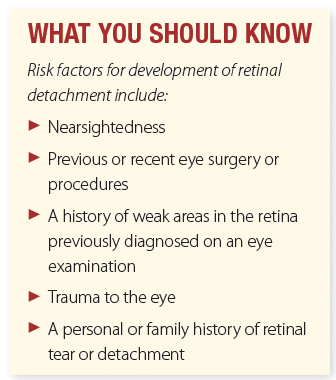Floaters or Flashes of Light in Your Vision Require an Eye Doctor ASAP
Several eye diseases and conditions can cause vision loss, and sometimes that loss cannot be corrected. However, one eye condition that can cause vision loss—retinal detachment—can be prevented, as long as you recognize the symptoms and get your eyes examined and treated quickly.
Eye Anatomy
To understand what retinal detachment is, it’s necessary to know where the retina is located and what its function is.
“The retina is a thin, intricate layer of nerve tissue that lines the inside back wall of the eye. If the eye were a camera, the retina would act like the ‘film.’ Light entering the eye is focused upon the retina, where the light signals are received and processed. The signals are then carried by the optic nerve (which acts like a ‘cable’) from the retina to the brain, where they are interpreted,” explains Mrinali Gupta, MD, assistant professor of ophthalmology at Weill Cornell Medical College.
If the retina separates from the wall of the eye, it is called a retinal detachment.

Reasons for a Detached Retina
“The most common type of retinal detachment is called a rhegmatogenous retinal detachment. These retinal detachments occur due to a break (like a hole or tear) in the retina,” explains Dr. Gupta.
Dr. Gupta gives this example to explain how a rhegmatogenous retinal detachment occurs: “Imagine that, if there were a tear in the wallpaper of your bathroom and it were left unaddressed, over time, as you took showers in the bathroom, the steam would get behind the tear and cause the entire wallpaper to start peeling. In a similar way, if there is a tear in the retina and it is left unaddressed, the fluid from the vitreous (the gel and fluid component that fills the back part of the eye) will enter through the tear and allow the retina to separate from the wall of the eye.”
As time goes by, the retinal detachment grows larger, which causes some symptoms to appear and others to become more frequent. If the condition is not treated, you may experience permanent vision loss.
There are two other types of retinal detachment. Exudative retinal detachment may be caused by diseases of the retina or injury or trauma to the eye. Tractional retinal detachment occurs when scar tissue on the retina contracts, pulling the retina away from the wall of the eye.
Warning Signs
Symptoms that suggest the development of a tear in the retina include new floaters or new flashing lights. “Floaters” are small shapes or specks that float around in your field of vision. Floaters are actually shadows of tiny fibers in the vitreous. They can look like spots, thread-like strands, “cobwebs,” or squiggly lines. The floaters move as your eyes move, although they do not follow your eye movements exactly.
Having floaters in and of itself is not a sign of an eye disease or condition; most people have some floaters, but they don’t interfere with clear vision. Floaters are usually not noticed until they become more numerous or more prominent.
The flashing lights may appear as tiny, moving spots of light that fade quickly and occur intermittently. People have described the flashing lights like seeing shooting stars or streaks of lightning. Occasional flashes of light are more likely to occur in older adults, and they are usually harmless, but if you suddenly start seeing repeated flashes, visit your eye doctor as soon as possible.
“If the tear progresses to a retinal detachment, the patient may notice a ‘shade’ or ‘curtain’ in their vision that may grow over time, or loss of vision,” says Dr. Gupta. “Fortunately, if a retinal tear is diagnosed and treated before the retina detaches, retinal detachment and permanent vision loss usually can be prevented.”
The post Floaters or Flashes of Light in Your Vision Require an Eye Doctor ASAP appeared first on University Health News.
Read Original Article: Floaters or Flashes of Light in Your Vision Require an Eye Doctor ASAP »

